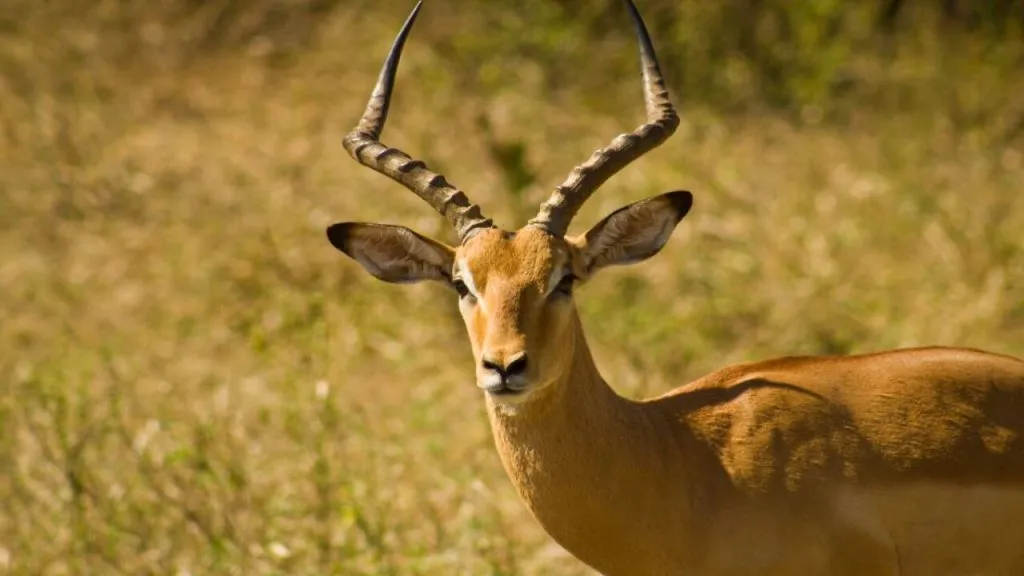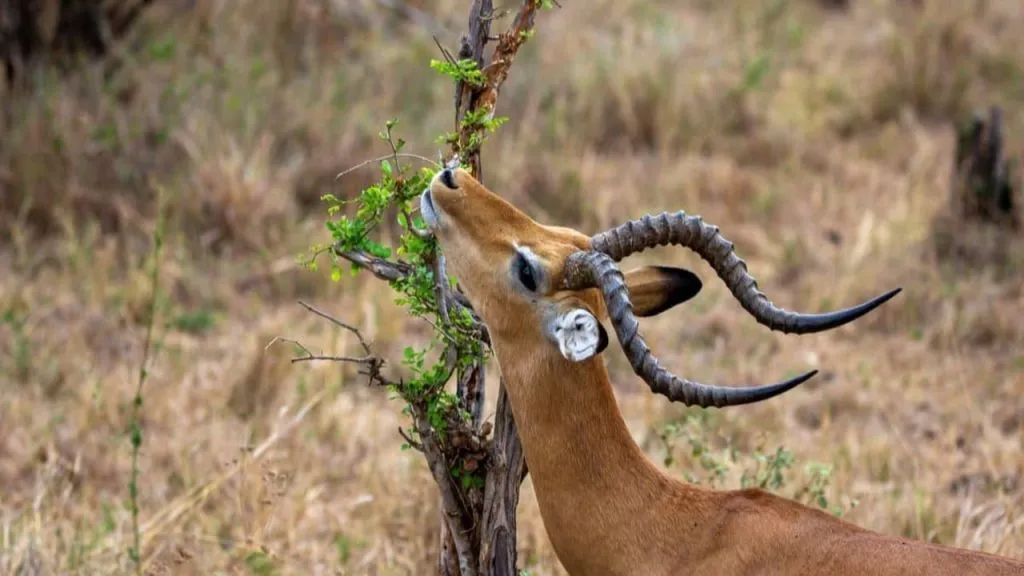As an Amazon Associate I earn from qualifying purchases.
Antelopes, known for their elegance with slender bodies and unique horns, live in various ecosystems worldwide.
Belonging to the Bovidae family, antelopes are present in many different types of regions.
Appreciating their significance in the natural order involves understanding what do antelopes eat and drink.
This article will explore different aspects of their dietary habits, from their physical features to the details of how they digest food.
But before we dive into that, let’s first explore their appearance and physical information.
Appearance & Physical Information
Antelopes have a lot of different physical features that make them special. They are known for their slim bodies, long legs, and curved horns.
These animals come in various fur colors and patterns, helping them blend in with their surroundings.
Antelopes are good at moving around because of their sleek bodies and strong muscles, allowing them to live in different places easily.
They have sharp senses, helping them notice things around them, which allows them to live in different environments.
In simple words, antelopes look graceful and can live well in many different parts of the world because of how they are built.
Types of Antelopes & Their Diet

Antelopes come in many types, more than 90 in fact, and each has its way of eating.
Most antelopes like to eat grass, leaves, and fruits, but some have special diets adapted to their specific living environments.
This variety in what they eat adds to the interesting and diverse food choices among antelopes.
1. Grazers
Let’s look at the Thomson’s gazelle, which lives in the big plains of East Africa. This speedy eater likes to munch on short grasses and herbs.
Also, there’s the impala, famous for its amazing jumping skills, and it enjoys eating tasty grasses and leaves.
2. Browsers
The gerenuk is a unique species known for its long neck and the impressive ability to stand on its hind legs.
These antelopes use this skill to reach for the nutritious leaves of acacia trees, a food source that most grazers can’t access.
The gerenuk’s browsing diet is crucial to its success, especially in arid regions where grasses are hard to find.
3. Mixed Feeders
Then there are antelopes such as the sitatunga, who live in swampy areas. These clever creatures eat a mix of different foods, like grasses, reeds, and even plants that grow in the water.
This shows how well they can live and eat in many different kinds of places.
Having explored the fundamental aspects of the various types of antelopes and what they eat, let’s now delve into the specifics of their eating habits throughout the year.
What do Antelope Eat and Drink Throughout the Year
1. Spring
In spring, when the rains make everything green again, lots of fresh grass and leaves grow.
Antelopes are happy because they get to eat this yummy and healthy food after a not-so-good winter.
Animals like the Thomson’s gazelle and impala eat a lot of the new grass, enjoying the juicy parts.
Some antelopes, like the sitatunga, even get to taste sweet fruits full of good stuff like vitamins and sugars, making their springtime meals even more delicious and surprising.
2. Summer
During the summer, antelopes have lots of yummy choices in their meals. Everything around them turns green and full of tasty plants.
The grasses are good, there are plenty of leaves to eat, and even flowers are like a special treat for those who like to try new things.
Some antelopes, like the gerenuk, stick to their favorite acacia leaves, while others, like the zebra antelope, mix it up by eating different plants like shrubs and herbs.
And to finish off their summer feasts on a sweet note, there are delicious fruits like berries and melons that become available, giving many antelope species a delightful and juicy treat.
3. Autumn
In the fall, the savanna turns golden as summer’s richness fades. The once-green grasses get old and dry, leaves fall gently, and there are fewer fruits around.
Antelopes adjust to these changes by eating tougher plants. Some nibble on woody shrubs and trees, while others, like the gemsbok, are good at getting nutrients from dried grass through their special digestion.
Since water is hard to find in the dry months, some antelopes, like the sable antelope, move to places with more water, while others, like the springbok, drink dew to stay hydrated.
4. Winter
Winter is a tough time for antelopes. The grass gets dry, leaves disappear, and fruits are all gone.
To deal with this, antelopes have smart stomachs that can get nutrients even from tough plants like shrubs and bark.
They have to be careful with water too. Some, like the oryx, can go a long time without drinking, while others rely on juicy plants to stay hydrated. It’s a real test of how well they can adapt during the winter season.
The Process of Antelope Digestion

1. Chewing
Antelopes start the process of digesting their food by chewing. They have a special stomach with four parts. In their mouth, they chew the food to make it smaller.
2. Stomach Chambers
Inside the stomach, the chewed food goes into the first part called the rumen. In the rumen, tiny living things like bacteria and other microorganisms team up to break down hard plant fibres.
They do this through a process called fermentation, and it helps to release the good stuff, like nutrients, from the plant material.
3. Rumen Contractions
Sometimes, the antelope brings back up a part of the fermented food called cud. This lets them chew it again to break it down more.
After chewing it well, they swallow it again, and it keeps going through their digestive system.
4. Additional Chambers
Next, the food that’s partly digested goes through more stomach parts like the reticulum, omasum, and abomasum.
In these parts, the food keeps breaking down, and the antelope’s body absorbs important nutrients.
Each stomach part has a special job in helping to break down the food and take out the important stuff the antelope needs.
5. Absorbing Nutrients
After the food is broken down, the good stuff, called nutrients, is taken into the antelope’s bloodstream through the walls of its stomach and intestines.
These nutrients give the antelope the energy and important elements it needs to stay alive and healthy.
6. Getting Rid of Waste
After all the useful stuff is taken from the food, the parts that can’t be used are put together to make pellets.
Then, the waste is removed from the antelope’s body in the form of poop, which is also called faeces.
Natural Predators of Antelope
Despite being fast and agile, antelopes face a constant challenge from major predators like lions, cheetahs, leopards, and hyenas.
This ongoing threat creates a crucial balance in nature, where the relationship between prey (antelopes) and predators is vital for the ecosystem.
This dynamic interaction affects how both antelopes and predators behave and survive, influencing their strategies for staying alive.
The persistent risk of being hunted plays a crucial role in keeping the environment in balance, ensuring that the interplay between plant-eaters and meat-eaters contributes to the long-term health and sustainability of the ecosystem.
Now that we’ve talked about what antelopes eat and the dangers they might face, it’s important to think about the places they live.
Let’s shift our focus to where these remarkable creatures reside and how their habitats impact their food choices.
Information About The Habitat
Antelopes do well in lots of different places, like big grassy areas, thick forests, and even deserts.
The cool thing about them is how good they are at living in all these different homes.
It’s important for people who work to keep nature safe (we call them conservationists) to know what makes each antelope’s home special.
This helps them make plans to keep antelopes safe and make sure their homes stay healthy for a long time.
The fact that antelopes can live happily in many different homes shows how vital they are for keeping nature diverse and balanced across different places.
Other Interesting Facts About Antelopes
- Antelopes are good at living in lots of different places. They can be in big grassy areas, dense forests, or deserts – they’re like nature’s experts in adapting to different homes.
- Many antelopes have special horns that are different in shape and size. These horns help them stay safe from danger, show who’s in charge, and attract friends.
- Antelopes are also social animals. They like to be together in groups, which helps keep them safe from predators. These groups can be big or small, and different antelopes have different ways of being social.
- They are super fast and can move quickly to avoid animals that might want to eat them. Some can run fast, which helps them survive in wide-open spaces.
- They have excellent senses like good eyesight, a strong sense of smell, and sharp hearing. This helps them notice danger early.
Conclusion
By learning about what antelopes eat and where they live, we now understand more about their diets and the places they call home.
Whether it’s the green grasslands or the deserts, antelopes are amazing at adapting, staying strong, and maintaining a careful balance with nature.
It’s imposing and makes us feel amazed by their abilities.
FAQ’s:
Antelopes are found in a variety of environments, ranging from grasslands and savannas to deserts and forests.
They adapt to different habitats based on the species, showcasing their versatility in surviving and thriving in diverse ecosystems.
Generally, antelopes are not known for their swimming abilities. They are more adapted to life on land and are excellent runners, relying on their agility to escape predators.
While some may navigate shallow water, swimming is not a common behavior observed in antelopes.
The young ones of antelopes are called calves. Just like many other ungulates, antelope calves are born after a gestation period, and they quickly learn to stand and walk shortly after birth.
These little ones are vital for the continued survival and growth of antelope populations.
Amazon and the Amazon logo are trademarks of Amazon.com, Inc, or its affiliates.

